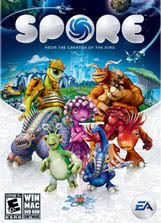
Genre: Arcade Racing
Publisher: Electronic Arts
Developer: Criterion Games
ESRB Rating: E for Everyone
Price: $29.99 USD
US Release Date: January 22, 2008
Equipment: Sceptre 37” widescreen LCD TV with HDMI cable in 720p, 60 GB PS3, DualShock 3 controller
Completion: Approximately 15 hours to earn Burnout License, additional 5 hours to complete Bike License.
It’s another day for you and me in Paradise.
Burnout Paradise answers the question, “What if you had a city all to yourself to race around in using a wide assortment of cars and bikes and there were no repercussions for all sorts of moving violations, up to and including the destruction of your car as well as other vehicles?” An arcade racer through and through, Burnout Paradise lets the player take corners at high speed, make impossibly tight turns, perform stupefying aerial maneuvers, and of course, completely and utterly annihilate any car in the city, before it pops back unharmed.
Paradise controls like any other arcade racing game on the market. The default layout uses the triggers for the gas and brake, but can be changed to use the face buttons for gas, brake, reverse, etc. The starting car and bikes are nothing too special, but still give a fantastic sense of speed. New cars are awarded after completing certain races, winning a certain number of events, gaining a new license, or by taking down special opponent cars speeding around the city. The vehicle progression is steady and rewarding; a stable full of cars is available after only a few hours of play. Any event in the city can be chosen right from the start of the game and tackled in any order. It’s even possible to completely ignore an entire event type and still “finish” the game. Events include point to point races, circuit races, time trials, road rage (where the objective is to make a specified number of opponent cars crash in a given time limit), stunt runs (where the objective is to score a set number of points by driving stylishly and recklessly), and marked man (where the objective is to reach a destination without crashing too many times while being pursued by aggressive opponents).
Nearly every intersection in the city is an event opportunity. Simply pull up to the light, smoke the tires, and go racing. Cars can be changed at any of a handful of junkyards around the city and drive-throughs offer repair, nitro, and paint services. While this menu-less system leads to a very immersive experience, it means that there is no way to quickly retry a failed race, or to change vehicles without driving back to the starting line or to a junkyard. Luckily, a new event is never very far away, and junkyards are evenly spaced around the city.
Since Paradise encourages driving as fast as possible, the city generally whizzes by, but at a flawless 60 fps. When details can be seen, they look fantastic. All the cars are shiny and reflective, with a large number of intricately detailed paint options. During crashes, slow-mo kicks in, and it’s possible to see tiny pieces of glass and twisted metal fly everywhere. Oddly enough, there are no driver models except on the bikes. Perhaps seeing what a head on collision at 120 mph would do to a driver in an open wheel race car would bump the rating up to M for Mature.
Just like any other EA game on the market, the soundtrack is extensive and varied. Hard driving rock, funky R&B beats, catchy pop, and even some smooth classical tunes make up the one and only radio station in Paradise. Music is interspersed with chatter from DJ Atomica, who can be a tad annoying. He also serves as the game’s tutorial, but he only mentions how to do something once the player’s already done it, which leads to quite a bit of trial and error.
Online play is seamlessly integrated with the single player mode. Just hit a button on the d-pad, invite a few friends, and go racing. All times from the single player mode are also uploaded automatically to the world-wide leader boards.
Being a Burnout game, the crashes are epic and spectacular, but no longer the focus of the game. In previous Burnout titles, the “Crash Mode” was the primary mode, with pure racing taking a back seat. Crash Mode is now know as “Showtime” and is relegated to an option while racing around the city. Nevertheless, Paradise is still very much an arcade racer, and still very much about crashing as an art form.
One other interesting thing about Burnout Paradise is the developer’s commitment to regular updates to the game. Since hitting shelves almost a year ago, a number of free updates and expansions have been released that do everything from fix bugs and glitches, to adding a day and night cycle, introducing motorcycles, new multiplayer modes, new cars and trophy support. Other packs have been announced that will expand the city with additional islands, add local multiplayer, and a new car with a brand new boost system. Not all of these will be free, but this type of continued support for a game that could easily turn into a yearly-release shovel-ware franchise is rare and very encouraging.
Arcade racing, blistering speed, spectacular destruction, beautiful environments, and fresh content updates: don’t think twice, it’s just another day in Paradise.
Heath Says:
I’ve always been a fan of the Burnout games for the Crash Mode. I could do arcade racing in any one of a hundred other games, but the Burnout series gave me the opportunity to take these amazing, high-performance machines and crash the shit out of them. In Burnout, crashing wasn’t something to be avoided, but embraced. It was my responsibility to crash these cars, simply in order to see how much devastation I could wreak with a two ton hunk of metal and an internal combustion engine. With Paradise, crashing is no longer the main event it was with the previous games, but rather a featured player. That saddens me, but the racing itself in Paradise is much better than in the previous games, so it balances out.
That’s not to say there are problems, of course. It would be great to have the option of restarting a race in the middle, or to retry a failed race immediately instead of quitting out and driving all the way back to the start line. A real tutorial mode would be helpful, and eliminate certain frustrations (such as trying to figure out how to quit out of a race). Also, even with all the updates, there are still bugs that are very obvious, both minor and major. Minor: new cars don’t accumulate mileage until they’ve been repaired and driven back to the junkyard. Major: if a bike is selected as your primary vehicle when loading up your saved game, trying to switch back to a car freezes the system, and the only way to fix it is to repaint the bike before returning to the junkyard.
If I’m being honest, though, all of those issues don’t really bother me when I look at the game as a whole. It’s just way too much fun to drive really, really fast and break things in the process. Plus, the updates keep the experience fresh. You can’t beat it for 30 bucks.
Final Verdict:






